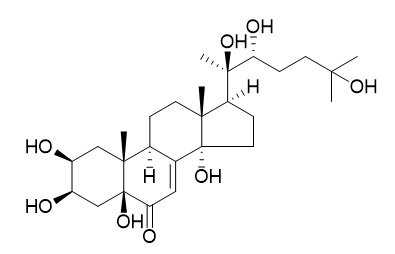Polypodine B
Polypodine B shows growth-promoting effects on in vitro development of the larval endoparasitoid, Venturia canescens (Hymenoptera: Ichneumonidae).
Inquire / Order:
manager@chemfaces.com
Technical Inquiries:
service@chemfaces.com
Tel:
+86-27-84237783
Fax:
+86-27-84254680
Address:
1 Building, No. 83, CheCheng Rd., Wuhan Economic and Technological Development Zone, Wuhan, Hubei 430056, PRC
Providing storage is as stated on the product vial and the vial is kept tightly sealed, the product can be stored for up to
24 months(2-8C).
Wherever possible, you should prepare and use solutions on the same day. However, if you need to make up stock solutions in advance, we recommend that you store the solution as aliquots in tightly sealed vials at -20C. Generally, these will be useable for up to two weeks. Before use, and prior to opening the vial we recommend that you allow your product to equilibrate to room temperature for at least 1 hour.
Need more advice on solubility, usage and handling? Please email to: service@chemfaces.com
The packaging of the product may have turned upside down during transportation, resulting in the natural compounds adhering to the neck or cap of the vial. take the vial out of its packaging and gently shake to let the compounds fall to the bottom of the vial. for liquid products, centrifuge at 200-500 RPM to gather the liquid at the bottom of the vial. try to avoid loss or contamination during handling.
Phytomedicine Plus2024, 4(4): 100655.
J.Korean Society of Grassland&Forage Science2023, 43(3):138-147.
ACS Omega.2021, 6(36):23460-23474.
Heliyon.2022, 8(12):e12031.
Iranian Journal of Pharmaceutical Sciences2021, 17(2):25-36
Antioxidants (Basel).2021, 10(3):379.
J Med Food.2024, 27(9):844-856.
Cosmetics2021, 8(3),91.
Russian J. Bioorganic Chemistry2024, 50:2897-2903.
Exp Neurobiol.2018, 27(3):200-209
Related and Featured Products
J Insect Physiol. 2000 Apr;46(4):467-476.
Growth-promoting effects of ecdysteroids and juvenile hormone on in vitro development of the larval endoparasitoid, Venturia canescens (Hymenoptera: Ichneumonidae).[Pubmed:
12770211]
We previously reported that lipophorin, fetal bovine serum (FBS), and 20-hydroxyecdysone (20-HE) are essential for the development of the larval endoparasitoid Venturia canescens larvae in vitro.
The present study was undertaken to determine the optimal concentrations of those three substances in the MGM-450 medium, and to examine the hormonal effects of ecdysteroids and juvenile hormone (JH) on the development of the parasitoid larvae in vitro.
METHODS AND RESULTS:
When the culture was started with embryos at the post-germband stage, concentrations of 3 mg/ml of lipophorin and 20% of FBS were most suitable for the development of the parasitoid. The growth-promoting effect of 20-HE increased in a concentration-dependent manner and peaked at a concentration of 1 &mgr;g/ml. Excess concentration led to malformations of the larvae. Three other ecdysteroids, ecdysone, 2-deoxy-20-hydroxyecdysone, and Polypodine B had the same effect, although their activity was lower than that of 20-HE. Cholesterol had no effect; most larvae failed to develop. When the medium was supplemented with JH, the duration of the developmental period was significantly shortened, but this hormone was not found to be essential.
J Insect Sci. 2010;10:13. doi: 10.1673/031.010.1301.
Dietary effects of four phytoecdysteroids on growth and development of the Indian meal moth, Plodia interpunctella.[Pubmed:
20575744 ]
METHODS AND RESULTS:
Using pure phytoecdysteroids isolated from Ajuga iva (L.) Schreber (Lamiales: Lamiaceae) and Silene nutans L. (Caryophyllales: Caryophyllaceae), plants known for their high ecdysteroid content, a study was carried out on the effects of ingestion of four different phytoecdysteroids (20-hydroxyecdysone, Polypodine B, ponasterone A and makisterone A) on the growth and development of the Indian meal moth, Plodia interpunctella Hübner (Lepidoptera: Pyralidae) larvae when added at a concentration of 200 ppm in their diet. The experiments clearly showed the susceptibility of P. interpunctella to phytoecdysteroid ingestion. The toxicity of phytoecdysteroids manifested itself by a decrease in larval weight, induction of cannibalism and an increase of mortality, together with disruption of development. The severity of the phytoecdysteroid effect on P. interpunctella depended on the structure of the molecule. The results demonstrate that the minimal structural differences existing between these four phytoecdysteroids significantly affected their toxicity toward P. interpunctella. Makisterone A was the most toxic of the four compounds towards P. interpunctella larvae.
CONCLUSIONS:
In conclusion, phytoecdysteroids ingestion evokes disruptive growth effects on P. interpunctella. This work supports a role for phytoecdysteroids in plant defence against phytophagous insects.



